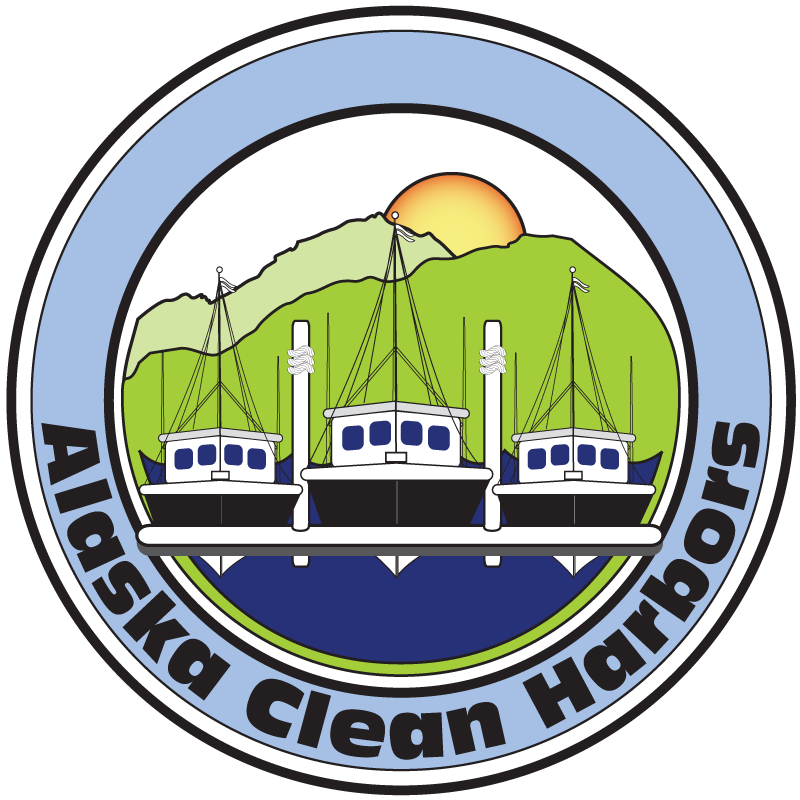Since 2010, Alaska Clean Harbors has worked with Harbormasters around Alaska to prevent pollution through the implementation of common sense best management practices.
Our program is voluntary and non-regulatory, based off of similar and successful programs found throughout many of the Lower 48 states. Based on a checklist of best management practices, Clean Harbor certification provides harbormasters and boaters with free tools and resources to reduce waste and minimize pollution.
Why Clean Harbors in Alaska?
Alaska's public harbors are vital economic and cultural centers in coastal and riverine communities around the state, and they serve both recreational boaters and a large commercial fleet. Additionally, Alaska's coastal waters and harbors are highly visible to outside visitors, and for many their first impression of Alaska's communities. At the same time, harbor basins are often considered "industrial zones" in Alaska. Options for hauling boats out for maintenance work can be limited, and a lot of necessary boat work is done on tidal grids, beaches and in slips within harbors. While local, state and federal regulations exist to ensure some measure of environmental responsibility over these activities, state and federal agencies are often challenged to oversee regulatory compliance. Additionally, there are a suite of unregulated activities in boat harbors that can cause pollution.
Pollution prevention is a necessary component of running a harbor, however it is one of many issues that are faced by harbor staff on a daily basis. Through Alaska Clean Harbors, our goal is to provide free technical assistance, tools and resources to help harbor staff protect Alaska's waters while running our important harbor facilities.
2007 - 2009
In 2007 a Clean Harbors Workgroup was initiated with funding from the Alaska Department of Environmental Conservation (ADEC) and the Cook Inlet Regional Citizens’ Advisory Council (CIRCAC), to create a Clean Harbors Guidebook as a management tool for harbor staff to use in pollution reduction activities. Although work has been done to increase prevention and better response to large-scale oil spills in Alaska, recent years have seen increased reports of small-scale spills in the marine environment. This project began with the understanding that more work is needed to help harbor staff and harbor users minimize their impacts on the marine environment on a site-by-site basis. The development of the Alaska Clean Harbors program was born out of this effort, and is based heavily upon the best management practices (BMPs) developed for Alaska and found within the Alaska Clean Harbors Guidebook.
2009 - 2016
In 2009, ADEC provided grant funds to Cook Inletkeeper to use the Clean Harbors Guidebook to develop the framework for a statewide program. We worked with other programs around the country and various stakeholders within Alaska to understand what was needed to best adjust “typical” Clean Marina programs to be successful in Alaskan harbors. To learn more specifically about how Clean Marina programs work in the Lower 48, Inletkeeper interviewed coordinators from seven Clean Marina programs, and spent three days visiting marina facilities with Clean Marina Washington in Seattle, Washington. These visits and conversations helped guide the development of the Alaska Clean Harbors certification program tailored for Alaska, with key points highlighted on what helps create a successful program.
During the fall of 2009, a Clean Harbors advisory committee was formed to provide ongoing feedback for the Alaska Clean Harbors program. The Committee was tasked with providing direction on the certification checklist components as well as reviewing and finalizing a logo for the program. During each meeting the Committee reviewed and provided suggestions for changes or updates to the BMP Checklist. There was also general discussion about the utility of a Clean Harbors program, and suggestions were made on what issues were of highest concern at different facilities. Information on current Advisory Committee members and meeting agendas and minutes are all available online.
“A lot of our customers are looking to do the right thing environmentally, but do not know how to do it economically and effectively. ”
The concept for an Alaska Clean Harbors program was presented to the Alaska Association of Harbormasters and Port Administrators (AAHPA) at their 2009 annual meeting in Kodiak, Alaska. The theme of the meeting was ‘Protecting Alaska’s Harbor Environment’ and the agenda included talks on marine debris, storm water management, as well as a presentation on the proposed Clean Harbors program. Attendees were asked to complete a survey on their facility and interest in a Clean Harbors program (see summarized results). We met with harbormasters and took tours of the facilities in Homer, Seldovia, Seward, Cordova, Juneau, and Sitka. Throughout the process, we worked with the communities of Homer and Seldovia to 'groundtruth' the program. With all of this feedback gathered and assessed, Inletkeeper staff with help from the Advisory Committee created the components of the full Alaska Clean Harbors program. The program went 'live' in 2010 and the Homer Harbor was the first facility certified in the state.
In 2011, Inletkeeper received funding a five-year grant through the Coastal Impact Assistance Program to continue and grow the Alaska Clean Harbors program. Extended till 2016, this grant provided us with an incredible opportunity to solidify this unique and invaluable program around the state. With this funding, Inletkeeper's Rachel Lord continued to be the program coordinator with the assistance of the Advisory Committee and based out of Cook Inletkeeper's office in Homer.
PRESENT
Beginning in mid-2016, Jen Karnik at the Marine Exchange of Alaska (home-based in Juneau) took over the program coordination role for Alaska Clean Harbors. Rachel continues to provide feedback and support for the program, with a minimized role for Inletkeeper. The Advisory Committee also continues to provide ongoing support for the program.

